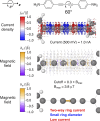Substantial Magnetic Fields Arising from Ballistic Ring Currents in Single-Molecule Junctions
- PMID: 40881421
- PMCID: PMC12381722
- DOI: 10.1021/jacsau.5c00735
Substantial Magnetic Fields Arising from Ballistic Ring Currents in Single-Molecule Junctions
Abstract
When a small electric bias is applied to a single-molecule junction, current will flow through the molecule via a tunneling mechanism. In molecules with a cyclic or helical structure there may be circular currents, giving rise to a unidirectional magnetic field. Here, we implement the Biot-Savart law and calculate the magnetic field resulting from the ballistic current density for a selection of molecules. We find that three prerequisites are important for achieving a substantial magnetic field in a single-molecule junction. (1) The current must be high, (2) the ring current must be unidirectional within the bias window, and (3) the diameter of the ring current must be small. We identify both cyclic and linear molecules that potentially fulfill these requirements. In cyclic annulenes with bond-length alternation the current-induced magnetic field can approach the mT-range whereas archetypical cyclic molecules, such as benzene, are not suitable candidates for the generation of a substantial magnetic field. In linear carbon chains with circular currents due to their helical π-systems, the magnetic field is in the mT-range. When the bias window is gated closer to resonance, we show that the magnetic field can potentially reach the sub-tesla range. Our results provide proof-of-concept for achieving experimentally relevant current-induced magnetic fields in molecular wires at low bias.
Keywords: Biot−Savart law; current density; magnetism; molecular electronics; ring current; single-molecule electromagnetism; single-molecule junction.
© 2025 The Authors. Published by American Chemical Society.
Figures






Similar articles
-
Prescription of Controlled Substances: Benefits and Risks.2025 Jul 6. In: StatPearls [Internet]. Treasure Island (FL): StatPearls Publishing; 2025 Jan–. 2025 Jul 6. In: StatPearls [Internet]. Treasure Island (FL): StatPearls Publishing; 2025 Jan–. PMID: 30726003 Free Books & Documents.
-
Electrophoresis.2025 Jul 14. In: StatPearls [Internet]. Treasure Island (FL): StatPearls Publishing; 2025 Jan–. 2025 Jul 14. In: StatPearls [Internet]. Treasure Island (FL): StatPearls Publishing; 2025 Jan–. PMID: 36251838 Free Books & Documents.
-
Systemic treatments for metastatic cutaneous melanoma.Cochrane Database Syst Rev. 2018 Feb 6;2(2):CD011123. doi: 10.1002/14651858.CD011123.pub2. Cochrane Database Syst Rev. 2018. PMID: 29405038 Free PMC article.
-
Education support services for improving school engagement and academic performance of children and adolescents with a chronic health condition.Cochrane Database Syst Rev. 2023 Feb 8;2(2):CD011538. doi: 10.1002/14651858.CD011538.pub2. Cochrane Database Syst Rev. 2023. PMID: 36752365 Free PMC article.
-
Healthcare workers' informal uses of mobile phones and other mobile devices to support their work: a qualitative evidence synthesis.Cochrane Database Syst Rev. 2024 Aug 27;8(8):CD015705. doi: 10.1002/14651858.CD015705.pub2. Cochrane Database Syst Rev. 2024. PMID: 39189465 Free PMC article.
References
-
- Gehring P., Thijssen J. M., van der Zant H. S. J.. Single-molecule quantum-transport phenomena in break junctions. Nat. Rev. Phys. 2019;1:381–396. doi: 10.1038/s42254-019-0055-1. - DOI
-
- Zhang H., Li J., Yang C., Guo X.. Single-Molecule Functional Chips: Unveiling the Full Potential of Molecular Electronics and Optoelectronics. Acc. Mater. Res. 2024;5:971–986. doi: 10.1021/accountsmr.4c00125. - DOI
LinkOut - more resources
Full Text Sources
Research Materials
Miscellaneous
